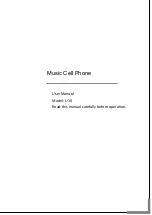
- 47 -
Copyright © 2009 LG Electronics. Inc. All right reserved.
Only for training and service purposes
LGE Internal Use Only
3. Technical Brief
3.9. Subsystem(MSM7200A)
3.9.1. ARM Microprocessor Subsystem
The MSM7200A device uses an embedded ARM1136-J, ARM926EJ-S microprocessor. This
microprocessor, through the system software, controls most of the functionality for the MSM,
including control of the external peripherals such as the keypad, LCD, SDRAM, and NAND-
Flash devices. Through a QUALCOMM proprietary serial bus interface (SBI) the ARM926EJ-S
configures and controls the functionality of the RTR6285 and PM7540
devices.
3.9.2. UMTS Subsystem
The UMTS Subsystem performs the digital UMTS signal processing. Its components include:
■
Searcher engine
■
Demodulating fingers
■
Combining block
■
Frame de-interleaver
■
Viterbi decoder
■
Up-link subsystem
■
Turbo decoder
On the down-link channel the UMTS subsystem searches, demodulates, and decodes incoming
CPICH, CCPCH, SCH, and Traffic Channel information. It extracts packet data from the downlink
traffic channel and prepares the packet data for processing. For the up-link, the WCDMA
subsystem processes the packet data and modulates the up-link traffic channel (DCH).
3.9.3. GSM Subsystem
The GSM/GPRS/EGPRS subsystem reuses the MSM6280 GSM core. It performs the digital
GSM signal processing and PA gain controls for GPRS support. The PA output level is controlled
by an analog signal generated on the MSM. In GSM mode, the power profile ramps up before
the burst and ramps down after the burst. In GPRS mode, at the beginning of each burst (up to
four active transmit slots), PA must be smoothly ramped up to some desired output power level,
held at that level for the current slot, smoothly ramped down/up during the transition period and
held to the new level for the next slot until the last slot. Then it must be smoothly ramped down
to near-zero level. The MSM6275 support differential GSM PA power control output.
The RF interface communicates with the mobile station external RF circuits. Signals to these
circuits control signal gain in the Rx and Tx signal path, control DC offset errors, and maintain
the system frequency reference.
3.9.4. RF Interface
The RF interface communicates with the mobile station’s external RF and analog baseband
circuits. Signals to these circuits control signal gain in the Rx and Tx signal path and maintain
The system’s frequency reference.
















































